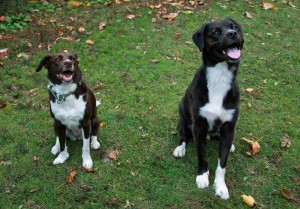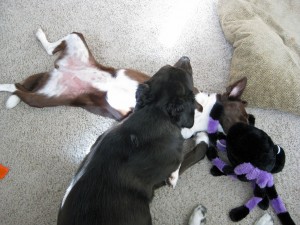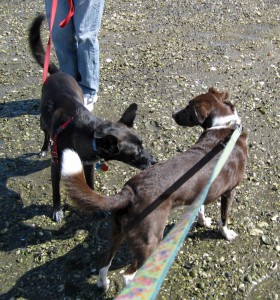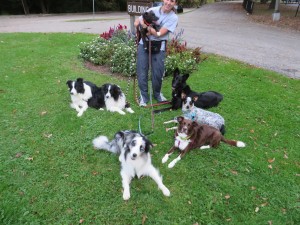A Reflection on Resolving Reactivity
The vast majority of my private training clients are dealing with some level of reactivity. Leash reactivity is something very close to home and personal for me. I’ve had a long journey with Shayne and her variety of “special features” but over the last few years, I’ve come to really feel like we are in a good place. She still has her vet phobia issues but I cannot remember the last time she had a big reaction on-leash. I was recently contacted by a client whose reactive dog was able to make a doggie friend and she was beaming with pride and excitement and it really got me thinking about the role of doggie friends and Shayne’s rehabilitation.
Shayne’s reactivity was probably somewhere in between frustrated greeter (part of her did want to see other dogs), fear (and lack of socialization so she got nervous when other dogs got too close so she’s snark/snap at them), and a touch of being a control freak. I knew off the bat she was not dog aggressive, but I wasn’t really sure if she was all that dog tolerant. She, at times, seemed to be unpredictable and I found her hard to read. Her first year or so with me was just about letting her be a dog, build some confidence, work on her resource guarding, and improve her fear aggression towards men/people. During the last part of that year, her leash reactivity really started to emerge, but I had enough on my plate with her behavior that it got managed and tolerated (given her other issues, leash reactivity was low on my priority list).
Her other behavior problems improved or resolved over time and her reactivity was easily managed by walking during off-hours, not going to parks or big doggie events, and doing lots of play in our yard. Any time she encountered other dogs was typically in controlled situations. Over the first two years I had her, she only really had one doggie friend, Bandit, her housemate.
Although I largely managed her reactivity, I had done a lot of counter conditioning with her and so her ability to co-exist in reasonably big spaces improved significantly (though it was not perfect by any means). With her reactivity improving, she had more opportunities to be around dogs, but still not in close quarters or really interacting because she was still reactive in tight spaces.

Shayne and Tas’ first off-leash adventure after a few weeks of leashed walks. You can see Shayne is still not 100% comfortable with her friend.
It was when I moved to New York that I saw the biggest change with her fear of people and her leash reactivity. With a higher population density of dogs and tight sidewalks to work on, we really had to work on continuing to decrease her threshold so she could be successful in the new environment. We weren’t always successful to start but we our skills improved. One of the most important pieces to her recovery, I believe, was starting to make doggie friends in New York.
A neighbor in my apartment building had a big friendly dog (Tassie) and, at their urging, we started to go for walks together. Knowing Shayne’s issues, I was always armed with treats and we started walking with some distance between us. It took quite a few walks until both dog could walk closely and would casually greet each other. Once walking them closely became a simple task, we upped the ante to see if the dogs could hang out in the same apartment so that we, the humans, could hang out.

This photo was taken almost exactly a year after the previous photo. It’s clear Shayne feels safe with Tassie and they have build a strong relationship!
The first few visits were done right after walks together but were nerve wracking for me. I was antsy and really had to focus on staying relaxed. On one of the first visits, there was a minor scuffle when Shayne and the other dog got “stuck” in a tight corner but it was easily broken up and both dogs went to separate beds to lay down (Shayne did end up with a puncture in her head but nothing big). The more we all hung out, the easier it was and the more Shayne seemed to enjoy her new found friends (both canine and human). This process of making a dog friend took quite a long time and was a lot of work, but she became best friends with this dog and they spent many weekends together when we traded dog-sitting.

This is probably one of the first times that the girls had a more formal greeting together after many walks together.
At the same time Shayne was making friends with my neighbor’s dog, we also started having meet-ups with a friend we met online (dog training community) who happened to live nearby, Risa (you can see a cool photo of their progress of getting to know one another here). Making friends with this pup was a bit more challenging because she too had some reactivity issues around other dogs but over the course of many weekly walking-dates, the girls became pretty decent buddies. They weren’t ever going to play together (though we got a play bow and invitation to play ONCE!) but they seemed to get excited to see one another during our walks. They did, however, learn to read each other pretty well and didn’t push buttons, they negotiated the relationship well. Their relationship was so strong in the end that not even a scuffle was something that could ruin it. We were on a walk with Risa and a couple other doggie friends when Risa’s leash got tangled around me and she panicked and snarked at Shayne (leaving a knick on her nose), when Risa got untangled, both shook off and continued on like nothing had happened.
It was about this time when her reactivity really became a non-issue except for very specific situations or trigger stacking. The only time Shayne would react at this point was if an unknown dog greeted her–she didn’t handle nose to nose greetings well and would snark. Fortunately this was extremely easy to manage by simply not allowing dogs to ‘say hi’ to her and continuing to counter condition when dogs were really close to her.
The process of making these first two serious doggie friends was pretty long–we had many walks with lots of distance between us before letting the dogs get close and do any sort of greeting. Nowadays, Shayne can do a little parallel walking with a new dog right next to her and within a few minutes they can be walking together and often can be good off-leash together. Although I still don’t fully test it, there is a good chance of a non-reaction even with a nose to nose greeting with an unknown dog. She isn’t perfect and will still snark if that dog is overly forward, stiff, or aroused (or just too pushy/rude) but I think that’s pretty fair.

Shayne on a walk with 3 dogs she didn’t really know, 2 of them she’d never met before. She walked confidently with all the new dogs, even if they got “up close and personal” with her!
I really think that process of meeting other dogs—building relationships, building communication skills, and building confidence made a huge impact with her reactivity. The more she felt comfortable with other dogs (and their normal range of behaviors), the less she felt the need to react to others. For a dog like Shayne, who was under-socialized and a little nervous about other dogs, but who was still curious about them, the act of making friends made such a big difference in her long-term success. It wasn’t easy and at times it was really stressful for me to feel confident her in new found skills and trust she wouldn’t get into trouble, but the hours spent taking many walks to slowly decrease distance between her and a hopeful new friend was so worth it. Now making friends is pretty much a breeze and she can act as a decoy dog in many situations with my reactive dog clients! She’s still not the best communicator with other dogs (it’s like she’s not a “native” canine speaker so there are some awkward moments), but she has far surpassed what I thought was possible!

Phoenix sounds a lot like Shayne. When I lived in the city we had way more opportunities to work on her reactivity and she was able to interact with most dogs. Now that we’ve moved to the country she’s totally regressed. I’ve been having a very hard time with her and I can’t walk her in the neighborhood at all because people just let their dogs roam and none are friendly. I’m hoping we can move back to the city soon and get back to work with her. She’s okay with most little dogs and not okay with large black dogs and other common type dogs like goldens. Or any other rude large dog that gets in her face.